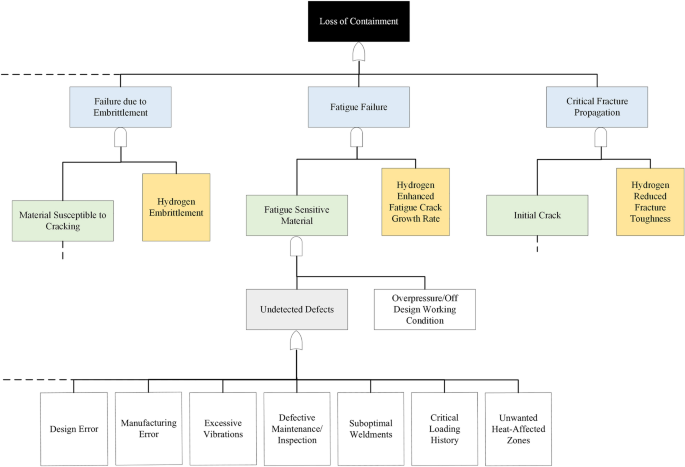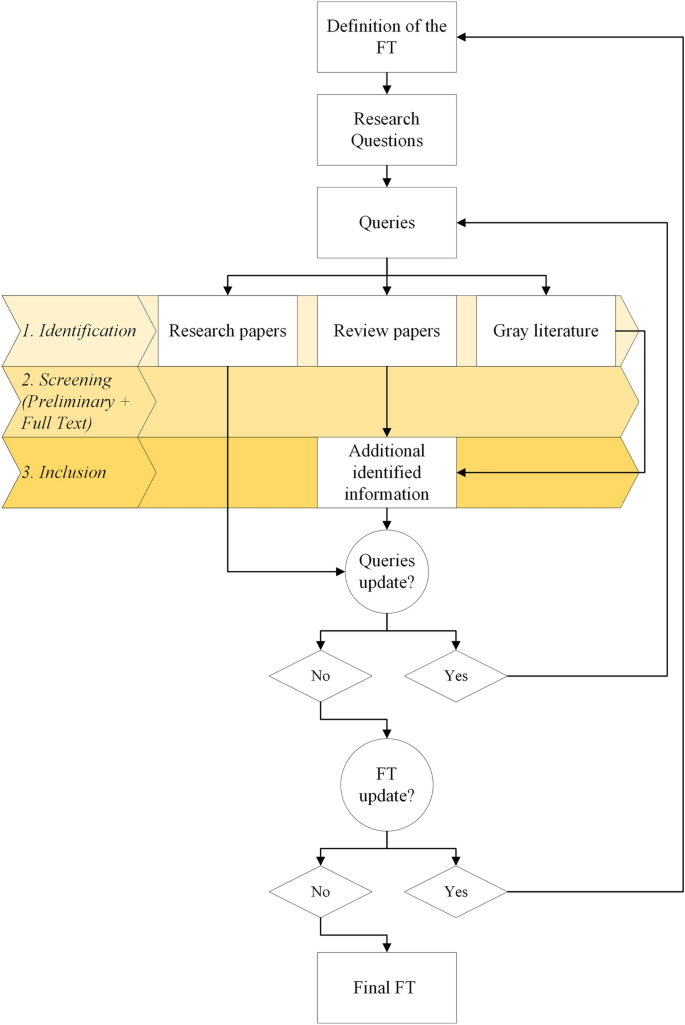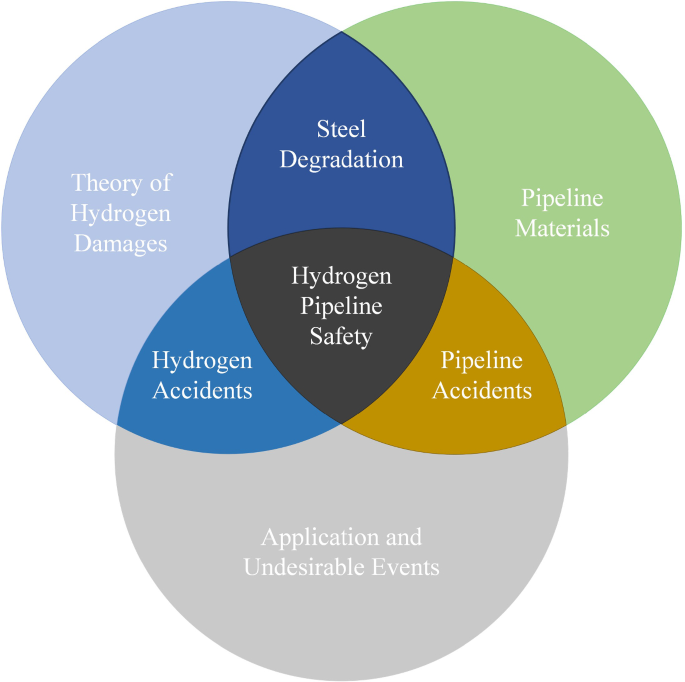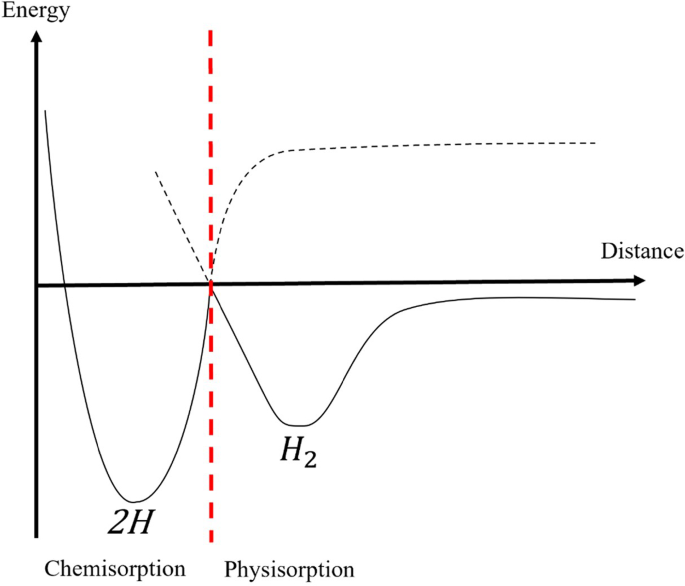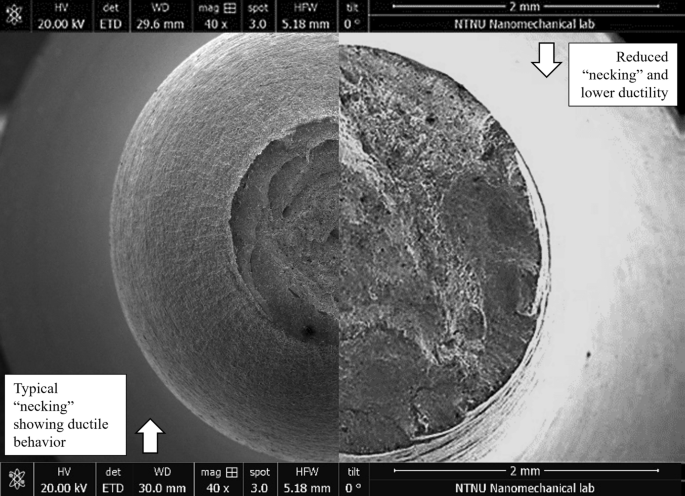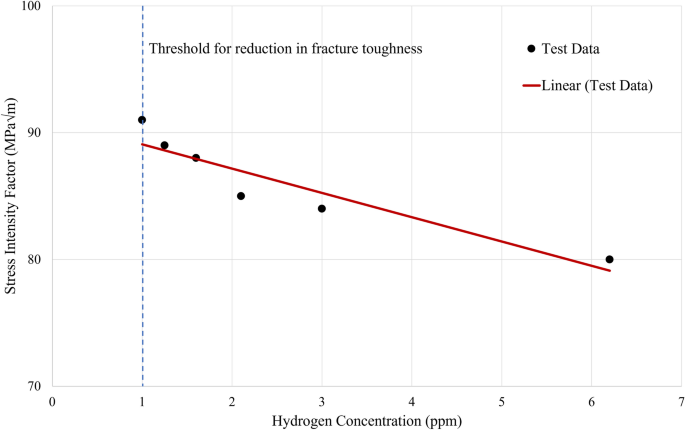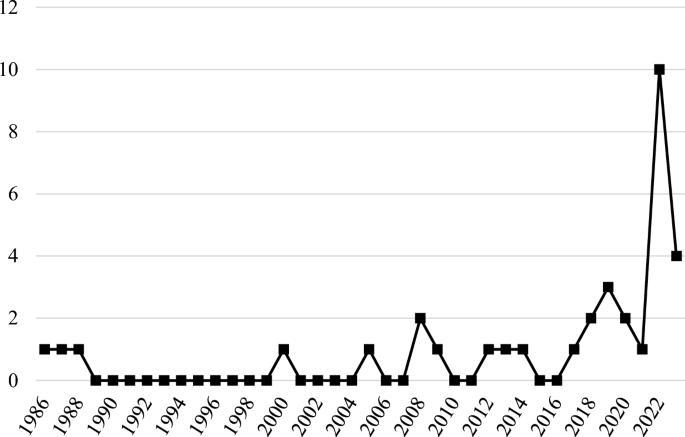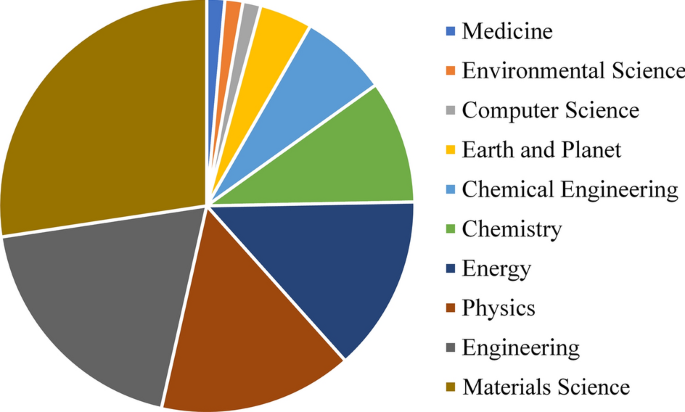Abstract
The detrimental effects induced by hydrogen on different materials—including steels—are a well-known and studied phenomenon. In the last century, several research papers focusing on hydrogen damages were published, including investigations concerning the hydrogen impact on the crack growth rate in steels subjected to cyclic loading. However, the past studies focused on material behavior and the role of external factors (e.g., pressure, temperature, stress field, microstructure, inhibitors, etc.), while the consequences of these findings on safety procedures and guidelines remain unspoken. The present work aims at investigating how the manifestation of the hydrogen degradation effect on equipment subjected to fatigue loadings may reflect on conventional safety practices. More accurately, a review of the parameters governing pipeline fatigue life is undertaken to analyze how such variables may lead to undesirable events and ultimately promoting a loss of containment scenario. In this sense, this work appeals for an evolution of the existing inspection methodologies for components that may experience fatigue failures (i.e., piping and pipeline systems), since the time-dependency of the detrimental effects induced by hydrogen should be considered in the operations of accident prevention and risk mitigation. Hence, the development of a preventive inspection and maintenance strategy specifically conceived for hydrogen technologies is essential to avoid the loss prevention of hydrogen systems. This will not only contribute to a quicker and larger scale spread of a hydrogen infrastructure, but it will also foster the energy-transition challenge that our society is facing today.
Graphical abstract
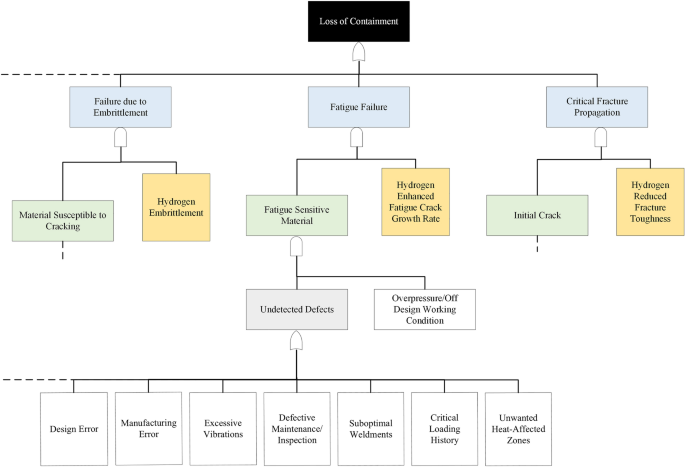
Similar content being viewed by others
Introduction
Following several decarbonization roadmaps1,2 and international sustainability projects, the hydrogen infrastructure is today slowly spreading, with numerous applications that foster its utilization in the automotive industry, the maritime sector, and even the aviation industry. The hydrogen value chain, which comprehends production facilities (e.g., solar panels and/or wind turbines coupled with electrolyzers to produce green hydrogen),3 storage and transport equipment (e.g., vessels and repurposed or newly installed pipelines), and dedicated infrastructure for the final utilization (e.g., refueling stations), shall in fact evolve in the following years, with the goal of producing, importing, and transporting up to 20 million tons of hydrogen by 2030.2 To support this value chain, the European Commission delivered a communication titled “A Hydrogen Strategy for a Climate Neutral Europe,” in which it indicates that planning of medium range and backbone transmission infrastructure should begin.4 Against this background, the concept of retrofitting and/or repurposing the existing pipeline grid, originally designed for natural gas transportation, has gained interest in industry, and tests on transporting methane-hydrogen blends were performed.5 In fact, research on integrity assessment protocols of repurposed gas pipes6 and management of hydrogen injection in the European gas network7 is already starting, aiming to enable a safe integration of hydrogen in the existing pipeline network. Under this premise, the main scope of this work is to investigate safety-related uncertainties concerning the integrity of this envisioned pipeline grid, reviewing the detrimental effects that hydrogen may induce on steels commonly implemented in the pan-European pipe-network and defining the parameters, working conditions, and variables that may influence the life of a hydrogen pipeline. In addition, these considerations aim at defining the factors that could promote loss prevention for a hydrogen pipeline, which could not only cause disastrous consequences, but may also inhibit the spread of hydrogen technologies undermining the social acceptability of the related infrastructure. This aspect is therefore deemed as crucial for the spread of hydrogen systems, whose development delay could also slow the overall energy transition process.
Hydrogen pipeline safety
Inspection and maintenance procedures for hydrogen equipment do not currently exist,8 and specific procedures should be developed in order to account for the degrading effects that hydrogen may induce on pipeline steels.9 Hence, it is understandable that the matters of hydrogen damage and material compatibility point in the direction of pipeline safety, and that risk analysis should focus on preventive measures and on mitigation of failure probability, along with consequence modeling that today apparently holds the lion’s share of publications on hydrogen safety. A fault tree analysis10 of a generic hydrogen pipeline would report some of the most relevant hydrogen-induced damages that may couple with material local flaws, thus fostering the likelihood of a LOC scenario. Figure 1 shows a fault tree (FT) that highlights criticalities which might favor the occurrence of a hydrogen accident. The black box indicates the accident event (loss of containment), and the light blue boxes describe the hydrogen-induced failures potentially leading to it. From left to right, Figure 1 indicates failures due to the loss of mechanical properties (i.e., due to hydrogen embrittlement), fatigue failure (i.e., related to hydrogen-enhanced fatigue crack growth rate—HEFCGR), and the hydrogen impact on the resistance against cracking (i.e., due to reduction of fracture toughness). The dashed lines indicate that the FT is not designed to be comprehensive, as it focuses on elements related to hydrogen-induced damages. The undesirable events10 are the basis of the FT, and they usually represent initial elements that could foster fatigue failure or that may be relevant for initiating cracks (vibrations, critical loading history, etc.) or for the susceptibility to cracking (design error, manufacturing error, etc.).
Fault tree describing initiating events and conditions that could foster a loss of containment of a hydrogen pipeline. The hydrogen-assisted degradation is indicated by the yellow boxes, which sum up the overall effect on mechanical properties, fracture resistance, and fatigue performances of pipeline steels. The fifth level (white square boxes) collects undesirable events10 that may lead to conditions favoring damages (undetected defects). Similar elements could be considered for the other green boxes (vertical dashed lines).
Methodology
The process of the systematic review is rooted in the research questions that this work aims at answering, as suggested by the guidelines proposed by Xiao and Watson.11 The research questions also arise from the elements in the FT (Figure 1), whose structure was refined and updated according to the results of the review process, as indicated in Figure 2. Hence, the research questions that this work aims to answer are the following:
-
Which is the existing information on steel-hydrogen interaction, and what are the consequences of such interactions on a macroscopical level?
-
Which are the conditions, variables, and parameters that favor the hydrogen damage on pipeline steels and what material characteristics are relevant for hydrogen incompatibility?
-
From a safety perspective, what is the current state of the art on hydrogen-assisted degradation of pipeline steels and what are the implications for planning inspections and maintenance on a hydrogen pipeline?
Flowchart highlighting the iterative process of the review methodology. The phases of the review process (“Identification,” “Screening,” and “Inclusion”) are described in detail in Table II. FT, fault tree.
To answer these questions, data were collected using the Scopus database12 and submitted queries related to the previously mentioned research questions. In particular, the queries were articulated on three subtopics reflecting the research questions:
-
1.
detrimental effects caused by hydrogen,
-
2.
research on pipeline steels and materials, and
-
3.
field of application (transport and storage), including unwanted events (e.g., accidents and loss of containment).
Table I reports the submitted queries (articulated in accordance with the research questions) that were then updated and tuned according to the results obtained from the systematic review process (see Figure 2).
As shown in Table I, the date of the records ranged from 1985 to 2024, the longest selectable range, and the research was limited to the English language. The queries were applied to the papers’ title, abstract, and keywords and the literature review was concluded on September 5, 2023. This resulted in a total of 57 publications (28 research articles, 21 conference papers, one book chapter, and seven reviews), which were scanned (screening process + inclusion/exclusion criteria) according to the reviewing methodology suggested by Xiao and Watson.11 In addition, the results of the systematic review were not only used to update the submitted queries,11 but also to refine the structure and the elements of the FT (Figure 1) that is the starting point of this work. The inclusion of a FT in the development of a systematic review method can be thus considered as a novelty, and the process of literature identification can also be easily inferred in Figure 3, which depicts the framework of the research.
After the identification of the literature and the screening procedure, some additional studies were identified through backward and forward search.11 Such studies were selected because indicated by the scanned literature reviews as crucial sources, therefore being particularly relevant to the scope of this work (as shown in Figure 2). Gray literature (book chapters, inspection planning standards, relevant reports on pipeline failure rates and conference papers) was only considered and referred when of particular interest. As reported in Table II, other publications were excluded, mostly because the term “hydrogen” present in the title, abstract and keywords did not refer to gaseous hydrogen, but rather to other chemical substances that have “hydrogen” reported in the name (i.e., hydrogen sulfide and hydrogen chloride). Additionally, some studies were excluded because they focused on the effect of sulfate-reducing bacteria on buried pipelines, materials different from steels, basic research on hydrogen diffusivity and solubility or because the full text was not available (see Table II). The information collected from the review process is narratively discussed as follows, while the bibliometric analysis and related results are reported in the “Key insights and reflections” section.
Metal−hydrogen interactions
This section discusses metal–hydrogen interactions that are relevant for pipelines working in hydrogen environments. Hence, hydrogen-induced detrimental effects that originate from corrosion processes (i.e., stress-oriented hydrogen-induced cracking, stress-corrosion cracking, etc.) are not considered. Laureys et al.9 reviewed the factors influencing the performances of pipeline steels facing a pressure-driven hydrogen uptake, which may be described as the increased fraction of hydrogen dissolved in the steel and promoted by the external pressure. The uptake process follows the steps of physisorption, chemisorption, and absorption,13 as indicated in Figure 4.
Qualitative chart describing the mechanisms of physisorption and chemisorption, as illustrated by Christmann.13 If a hydrogen molecule is close enough to the metal surface, the chemisorption mechanism takes place and molecular dissociation is favored. This process acts as a source of atomic hydrogen, which may then recombine or diffuse toward the subsurface region of the steel (absorption).
Once atomic hydrogen enters the material, it can diffuse toward areas characterized by residual stress, local flaws, dislocations, and traps, and it may lead to a loss of cohesive strength, thus enhancing material degradation and ultimately cracking.14 Villalobos et al.14 also pointed out that even few ppm of hydrogen can cause loss of ductility and promote cracking, especially in high strength steels. Such penetration potential depends on a series of variables, including the surface condition of the steel and the presence of impurities or blending with additives.9 The final effect at a macroscopic level consists in the inhibition of critical mechanical properties, which is usually referred to as hydrogen embrittlement (HE). In fact, HE is responsible for the deterioration of tensile properties (i.e., elongation to failure15 and ultimate tensile strength16) and for the reduction of fracture toughness (i.e., the resistance to fracture propagation).17,18,19 Moreover, other studies investigated the reduction of the fatigue endurance of steels working in gaseous hydrogen environments under different operative conditions (i.e., temperature, pressure, frequency) and cyclic loadings.9,20,21,22 More details concerning the affected properties are reported in the next sections.
Loss of ductility
As the name hydrogen embrittlement suggests, one of the main results of hydrogen permeation in steels is the induced loss of ductility. Stalheim et al.23 conducted comparative tensile tests on a commercial X70 pipeline steel (nomenclature of API 5L24) in hydrogen and helium environments, proving the poorer ductility of the steel when tested in hydrogen at 5.5 MPa. In addition, X65 specimens were electrochemically charged with hydrogen25 and tested to measure the induced loss of ductility (Figure 5). In both works, the area reduction was measured to evaluate the ductility loss, and a more pronounced embrittlement was obtained at slower strain rates, indicating that the time of exposure to the hydrogen environment is a key variable in the process of embrittlement.23 This aspect seems consistent with other experimental evidence, as pointed out by Slifka et al.21
Hydrogen-induced loss of ductility on a X65 pipeline steel. On the left, the steel was tested in an inert environment, and it shows a typical “cup and cone” ductile cracking. On the right, the steel was electrochemically charged with hydrogen, and it shows a more brittle behavior and lower ductility (from the research work conducted in Reference 25). The arrows indicate the reference to the specific scale bar.
Reduction of fracture toughness
Hydrogen also affects another crucial property of pipeline steels: fracture toughness. Li et al.26 discussed recent advances in embrittlement characterization and mitigation, pointing out a lack of direct evidence on how hydrogen segregation can lead to the propagation of cracks. Even if an agreed upon hydrogen degradation mechanism is missing and a fracture toughness testing procedure is under development in different ongoing projects around the world, it is clear that hydrogen uptake negatively impacts the materials resistance against cracking. A thorough analysis of this phenomenon is not strictly related to the safety-driven nature of this work, but additional specific literature on the topic can be consulted to deepen this aspect.27,28 In any case, experiments on hydrogen pre-charged specimens were carried out by Wang,18 who investigated crack propagation on X70 specimens and suggested a critical hydrogen concentration of 1 ppm as a threshold for the reduction of fracture toughness. Above such threshold, the author obtained a linear correlation between the hydrogen concentration in ppm (\({C}_{H}\)) and the critical stress intensity factor (\({K}_{IQ}\)) expressed in \(MPa\sqrt{m}\), as illustrated in Figure 6.
Reduction of the fracture toughness of a X70 specimen pre-charged with hydrogen for different concentrations. Data from Reference 18. © 2009 Elsevier.
In addition, Mendibide et al.29 studied the effects of humidity on hydrogen permeation, indicating that it can slightly increase the severity of the environment and therefore lead to a potential reduction of fracture toughness. It should be noted that for an operating pipeline the welds resistance to cracking is of paramount importance, and that the crack propagation of these areas can differ from the one of the base metal. Hence, Chatzidouros et al.30 and Giarola et al.19 studied the effect of hydrogen on the fracture toughness of steel welds, investigating X52 and X70 electrochemically charged specimens and comparing the results with the properties of the base metal. Surprisingly, they found that the microstructure of the heat-affected zone (i.e., the areas affected by microstructural modifications during welding processes) was less susceptible to hydrogen degradation than the base metal. The authors indicated that a possible explanation of the phenomenon could be the trapping of hydrogen in the continuous interfaces between the microstructures of the base metal.30 However, the data showed considerable dispersion and are in contrast with the results reported in other publications concerning heat-affected zones (HAZs).28,31 In fact, HAZs and welds are known to be particularly delicate areas of pipelines, so further studies concerning their compatibility with gaseous hydrogen transport should be carried out, especially conducting tests in pressurized hydrogen environments.
Inhibition of fatigue performances
During its operative life, a pipeline is often subjected to cyclic loadings that may be caused by the fluctuations in the pressure level induced by variations in the load of the connected utilities and/or by the movement of the seabed in the case of subsea pipelines. Even if not completely clarified yet, the presence of hydrogen can reduce the threshold cyclic stress intensity factor (\(\Delta {K}_{th}\)), thus promoting fatigue cracking and reducing the pipeline’s operative life.32 On a more general basis, Laureys et al.9 and Hagen and Alvaro15 also reviewed the fatigue performances of pipeline steels in hydrogen environments, investigating the factors affecting hydrogen-induced degradation. Several studies were also reviewed by Li et al.,26 indicating the role of natural gas blending in the inhibition of fatigue crack propagation in pipeline steels. In fact, several conditions, variables, and parameters affect the fatigue behavior of X-grade steels operating in hydrogen environments. Pressure, temperature, loading frequency, hydrogen gas impurities and inhibitors, steel grade, surface conditions, loading history; all these variables interdependently play a role in the determination of the fatigue performances of a hydrogen pipeline, thus increasing or reducing the likelihood of failure and potentially fostering LOC scenarios. The next section delves more in detail into these aspects, discussing such factors and providing critical elements obtained from the review process.
Parameters affecting crack growth in hydrogen environments
Metallic equipment working in high-pressure hydrogen environments and subjected to cyclic loadings is known to be potentially susceptible to fatigue failure, and numerous studies highlighted the variables influencing the crack growth during different tests. The main parameters are collected and described as follows.
Hydrogen pressure
Faucon et al.31 conducted in situ fatigue tests on X60 hollow specimens, focusing both on the base and the weld metal. Unlike the findings reported in Reference 30, they noticed that hydrogen accelerated the crack growth by a factor of four for the base metal and by a factor of eight in the welded steel. This resulted in a reduced life of 37% and 57%, respectively, proving that the hydrogen damage is more severe on weld metal under fatigue conditions—which is also confirmed by numerical simulations of crack propagation in heat-affected zones, as indicated in additional literature.33 Interestingly, no difference in the fatigue behavior was detected at a hydrogen pressure ranging between 7 and 15 MPa, hinting that a saturation pressure for hydrogen diffusion was reached at around 7 MPa. Nonetheless, the tests were conducted using an unstandardized geometry (hollow specimen technique) and focused on low cycle fatigue regimes (which may not be the most relevant for pipeline working conditions). Therefore, more data could be needed to prove such results. Conventional fatigue experiments were carried out by An et al.20 on a X80 pipeline steel to investigate the influence of the hydrogen pressure on the enhancement of the fatigue crack growth rate (FCGR). Their findings show that the FCGR doubles when the hydrogen pressure is increased from 0.2 to 8 MPa. Both works20,31 indicate that the hydrogen pressure plays a pivotal role in the enhancement of the FCGR, as also stated by Briottet et al.,34 who conducted similar tests on a X80 steel in hydrogen at 30 MPa.
Loading frequency
Another crucial parameter in the assessment of hydrogen fatigue damages is the frequency of the load. It is in fact established knowledge21,35 that low frequencies promote hydrogen degradation, since the latter has more time to diffuse at a crack tip – a phenomenon that was also investigated through numerical modeling.36 Slifka et al.21 tested X52 vintage and modern steels (the production year is another relevant variable, since same grade steels produced in different periods can be microstructurally different due to a different chemical composition) proving the FCGR dependence on frequency when it varied between 1 and 0.01 Hz. In addition, it should be noted that fatigue tests at low frequencies are usually extremely time-consuming and expensive. As a result, a limited amount of data is currently available for modeling and monitoring the degradation mechanisms.9 Interestingly, an extensive discussion on the topic can be found in an additional previous publication,37 in which a thorough study concerning the effect of frequency on the fatigue performance of austenitic steels was carried out.
Operating temperature
As previously mentioned, the effects of pressure and frequency on the steel susceptibility to hydrogen-induced degradation appear to have a monotonic nature. However, this aspect seems not to be valid for temperature. According to previous studies, high temperatures enhance hydrogen mobility in the bulk phase of steels, thus promoting detrapping and desorption.9,22 The desorbed hydrogen can also be quantitatively measured,26 thus establishing a relation between the specimen temperature and the released hydrogen. In fact, some studies point out that the worst condition in terms of maximum HEFCGR is at ambient temperature, while it becomes more negligible at higher temperatures.32 On the other hand, Laureys et al.9 report that below room temperature the hydrogen effect on FCGR decreases in relation with its lower diffusivity, which is on the order of \({10}^{-10}{\text{m}}^{2}\text{/s}\) for body-centered cubic (bcc) iron structures.15 From these considerations, it may be inferred that a temperature value which maximizes the hydrogen effect can exist, and Frandsen and Marcus38 proved it for a high-strength alloy steel (HP 9-4-20), indicating that a maximum susceptibility is reached at around 273 K (0℃).
As mentioned, other variables and parameters influencing hydrogen-induced fatigue failures do exist, and they include material characteristics (microstructure, grade, strength) and the presence of other chemicals in the gaseous phase (inhibitors, promoters). The following section discusses these aspects, focusing on the role of materials and gas blending in a LOC scenario and outlining the importance of dedicated inspection and maintenance procedures.
Loss of containment of a hydrogen pipeline
Material characteristics are crucial in terms of hydrogen compatibility. ASME (the American Society of Mechanical Engineers) developed a standard39 to provide guidelines on steel requirements for hydrogen transport in piping and pipeline systems, defining operative pressure limits depending on the steel grade. High grade steels (i.e., X100) are in fact typically more susceptible to hydrogen-induced loss of ductility,16,21 therefore ASME39 suggests using lower steel grades for hydrogen transport or limiting the operative pressure. However, both Slifka21 and Stalheim40 noted that, thus affecting the hydrogen-assisted loss of ductility, the yield strength does not have a dominant effect on fatigue performances. In fact, the fatigue tests conducted by Slifka et al.21 show that the FCGR is not affected by the steel grade. Nevertheless, the crack growth mechanisms can vary depending on the tested material,41 and a thorough and comprehensive standard for steel selection should consider this aspect, possibly also evaluating the potential presence of inhibitors, as explained as follows.
Inhibitors
An important variable influencing hydrogen-assisted fatigue failure is the presence of inhibitors. Such elements can decrease the hydrogen presence in the steel, by either affecting its diffusivity or by providing some shielding effect to the pipeline surface. With respect to gaseous elements, oxygen and carbon monoxide seem to show a dominant inhibiting effect,9 while a more modest inhibition can be obtained with methane blending, because the latter seems to affect hydrogen adsorption at high-angle grain boundaries, a common trap for hydrogen accumulation in steels.42 Moreover, Xu et al.43 studied the effect of lanthanum salt (\({\text{La}}^{3+}\)) on hydrogen permeation into steel. Although the study may have limited implications for gaseous hydrogen transport (the tests were conducted in acidic solutions), it should be noted that the addition of \({\text{La}}^{3+}\) considerably limited the hydrogen degradation of a X70 pipeline steel by forming a protective film on its surface. In addition, a theoretical study was carried out by Li et al.44 in which the authors investigated the inhibiting effect of iron oxide (\({\text{Fe}}_{2}{\text{O}}_{3}\)) on hydrogen permeation in iron, suggesting that the oxide could protect steels from hydrogen-induced degradation. However, a pipeline can extend for hundreds or even thousands of kilometers, and to the author’s best knowledge there are currently no studies pointing out the possibility of considering an inhibiting effect constant over such lengths. Hence, pipeline sections could be prone to hydrogen-induced failures disregarding the presence of inhibitors. In any case, the blending with inhibitors can be an interesting element for the safety of hydrogen pipelines; however, this topic seems generally overlooked.
Indeed, hydrogen pipeline safety itself seems to be a mostly overlooked topic, even if some past studies tried to cast light on this field. Briottet et al.34 were among the first to conduct FCGR tests on an X80 grade in a hydrogen environment to discuss safety implications, and their work suggests the development of qualification tests and redaction of standards to evaluate materials compatibility with hydrogen transport from a safety perspective. However, the problem was already pointed out by Mohitpour et al. in 1988,45 who advocated for the development of specific codes for hydrogen pipelines based on the hydrogen’s unique characteristics. Within this review process, the only journal publication entirely dedicated to hydrogen pipeline safety is attributed to Khwaja and Paul,46 who discussed advantages and disadvantages of different inspection techniques for coated hydrogen pipelines. Interestingly, Dmytrakh et al.47 proposed a special diagram for the evaluation of hydrogen damage on pipeline steels, and the authors indicated its potential application in the interpretation of inspection results of long-term operated pipelines. Hence, the limited literature concerning hydrogen pipeline safety, especially focusing on inspection and maintenance procedures, is a symptom of a general miscommunication between materials science and risk analysis, which also underlines an overall lack of international harmonization of operational safety protocols. A further discussion of this aspect is presented in the next section, along with all the findings of the systematic review process and implications for future research.
Key insights and reflections
The queries reported in the “Methodology” section resulted in 57 documents found on the Scopus database (28 articles, 21 conference papers, seven reviews, and one book chapter). In addition, a backward-forward search11 led to the inclusion of some other relevant publications, as explained in the “Methodology” section. Moreover, gray literature (conference papers initially excluded and important technical reports, standards, and codes) was considered when particularly relevant, and Table II describes the review process initially indicated in Figure 2.
As shown in Table II, the available literature concerning hydrogen pipeline safety is quite limited. However, the number of documents spiked between 2022 and 2023 (Figure 7), showing increased attention toward the subject.
Overall, the interest toward the development of a large-scale hydrogen infrastructure is quite recent1,2,4,6,7 and it is safe to assume that the trend shown in Figure 7 will continue in the following years. However, upon examining the results based on subject area (as depicted in Figure 8), it becomes evident that the domain of “materials science” is prominently the most discussed and studied, accounting for 27.4% of the records. In fact, it should be noted that the field “engineering” is quite heterogenous, and the few records34,45,46 concerning safety aspects (albeit to a limited degree) are collected in this area.
To get a better understanding of the ongoing research, the results were analyzed with the software VOSviewer,48 which performs bibliometric analyses of records. First, the authors were categorized on the number of publications and citations. The number of authors of the 35 original journal publications was 148, while a total amount of 3923 authors was cited by the documents, of which 16 are considered as highly cited (each cited more than 20 times in the records), and Figure 9 was developed based on the number of co-citations (i.e., the number of times two authors are cited together).
Number of co-citations based on the authors and weighted (circle sizes) on the total number of citations of an author. The different colors indicate author clusters and are used to highlight researchers that are strongly related to each other.49
As indicated in Figure 9, the research network seems well connected and experts on the field tend to cite each other quite often. The topic of the research is almost always materials science, physics, or chemistry, and this is inferable by the keywords of the publications. Considering the index keywords that appear at least two times and plotting a co-occurrence chart (i.e., the number of times the different keywords appear in the same document) Figure 10 can be obtained.
Co-occurrence of index keywords weighted on the number of times they appear (circle sizes). The relatedness of items is established on the number of times they appear together. The different colors indicate keyword clusters and are used to highlight words that are strongly related to each other (they often appear in the same publication together).49
Figure 10 collects a total of 69 index keywords that are clustered in different topics or fields (the software clusters keywords together based on a clustering technique that uses a resolution parameter49). The four clusters (indicated by the different colors) merge together in the most used index keywords: hydrogen embrittlement, hydrogen, pipelines, and steel pipe. The green cluster is the most heterogenous; it collects keywords concerning applications, economy, materials, and fracture analysis. The blue cluster is mostly characterized by materials and applications (natural gas pipelines and transportation, high strength steel, welds, and hydrogen storage) whereas the red cluster has a more chemical nature, focusing on corrosion, cathodic protection, sulfide, and dissolution. Finally, the yellow cluster collects keywords typical of physics studies, such as density functional theory, atoms, and hydrogen permeation. Again, no keywords concerning safety aspects are present, highlighting once again the lack of research concerning hydrogen pipeline safety. Moreover, the keywords “inspection,” “maintenance,” and “loss of containment” never appear even if they are explicitly reported in the submitted queries (Table I), showing that literature concerning hazards prevention and risk assessment of materials subjected to hydrogen-assisted failure is still mostly unpublished and/or unavailable. Some other considerations regarding this aspect are reported as follows.
Implication on inspection and maintenance planning
As demonstrated with this work, hydrogen pipeline accidental prevention (intended as inspection and maintenance planning) is still largely undebated and the implications of hydrogen damage on safety aspects remain vastly unspoken. It should be noted that the hydrogen damage, although not completely understood, is a long-studied phenomenon and the conducted review confirmed a well-known aspect that most experts agree with: hydrogen-induced degradation of mechanical properties (loss of ductility, reduction of fracture toughness, and inhibition of fatigue performances) is strongly dependent on a complex interaction of a series of interlinked variables that encompass material properties, exposure conditions and mechanical characteristics. However, this work also highlighted a critical research gap concerning the consequences of hydrogen-induced damage on operational safety. Hence, the results of the review process indicated that:
-
1.
The implications of recent advancements and progress in materials science are currently disregarded for what it concerns the operational safety of hydrogen transport via pipeline.
-
2.
Hydrogen damage can play a pivotal role in fostering the likelihood of a LOC of a hydrogen pipeline via embrittlement effect, reduction to fracture toughness, and assisted fatigue crack propagation (as indicated in Figure 1).
Hence, the results of the systematic review hint that hydrogen-induced degradation effects are investigated by teams of materials scientists, while safety analysists are not involved in the activity. In fact, the author network (Figure 9) and the index keywords (Figure 10) clearly show that RAMS (reliability, availability, maintainability, and safety) research does not delve into the topic. This research gap is believed to potentially hinder the optimization of inspection and maintenance procedures for hydrogen pipelines, since risk uncertainties could result in the adoption of over-conservative safety measures. Such measures may comprehend inspection programs characterized by short inspection intervals to ensure preventive crack detection, but that can pose unsustainable economic and financial burdens potentially reducing the economic attractiveness of this technology. Therefore, future research should focus on the development of dedicated and optimized safety guidelines and strategies for hydrogen pipelines, vital to ensure optimal operational safety. Finally, this has critical implications for inspection and maintenance activities of such equipment, because the risk picture evolves with time,50 and a static risk evaluation conducted in the design phase could be insufficient to evaluate the increasing probability of failure of hydrogen systems, potentially leading to hazardous scenarios.
Conclusion
This work addressed the existing state of the art concerning metal–hydrogen interactions in pipeline steels under the lens of operational safety, with particular attention paid to the role of inspection planning and preventive maintenance in the scenario of a LOC of a hydrogen pipeline. The review process started from the development of a FT (Figure 1) further updated and refined according with the obtained information. Such iterative process (Figure 2) was used to adapt the review methodology proposed by Xiao and Watson11 to the field of pipeline safety, thus proposing a novel approach in the definition of the research queries. The following bullet points sum up the main conclusions of this work:
-
Metal–hydrogen interactions are a known and long studied phenomenon constituting a central debate in materials science, and numerous studies have highlighted the effects of hydrogen on mechanical properties and crack propagation.
-
With respect to pipeline steels, the existing research discusses the role of environmental conditions, mechanical loadings, inhibitors, and degradation on the integrity of materials, with particular attention paid to mechanical failures and the reduction of the steels’ performances.
-
Research on prevention, maintenance, and safety is still mostly unpublished when it comes to hydrogen-assisted failures, since the number of publications discussing the implications of hydrogen degradation on safety aspects is still extremely limited. However, the recent spike of the existing literature on the topic shown within this work could be a hint of the direction of the research, and unknown criticalities might be underlined in the near future.
Data availability
Literature database and relative data are available upon request.
References
European Commission, Secretariat-General, “The European Green Deal” (2019). https://eur-lex.europa.eu/legal-content/EN/TXT/?uri=COM:2019:640:FIN
European Commission, Secretariat-General, “REPowerEU Plan” (2022). https://eur-lex.europa.eu/legal-content/EN/TXT/?uri=COM%3A2022%3A230%3AFIN&qid=1653033742483
J. Incer-Valverde, A. Korayem, G. Tsatsaronis, T. Morosuk, Energy Convers. Manage. 291, 117294 (2023). https://doi.org/10.1016/j.enconman.2023.117294
European Commission, Secretariat-General, “A Hydrogen Strategy for a Climate Neutral Europe” (2020). https://eur-lex.europa.eu/legal-content/EN/TXT/?uri=CELEX:52020DC0301
I.A. Makaryan, I.V. Sedov, E.A. Salgansky, A.V. Arutyunov, V.S. Arutyunov, Energies 15(6), 2265 (2022). https://doi.org/10.3390/en15062265
European Commission, “Pre-Normative Research on Integrity Assessment Protocols of Gas Pipes Repurposed to Hydrogen and Mitigation Guidelines” (2024). Accessed 13 Feb 2024. https://www.clean-hydrogen.europa.eu/projects-repository/pilgrhym_en
European Commission, “Safe Hydrogen Injection Modelling and Management for European Gas Network Resilience” (2023). Accessed 13 Feb 2024. https://www.clean-hydrogen.europa.eu/projects-repository/shimmer_en
A. Campari, F. Ustolin, A. Alvaro, N. Paltrinieri, Int. J. Hydrogen Energy 48(90), 35316 (2023). https://doi.org/10.1016/j.ijhydene.2023.05.293
A. Laureys, R. Depraetere, M. Cauwels, T. Depover, S. Hertelé, K. Verbeken, J. Nat. Gas Sci. Eng. 101, 104534 (2022). https://doi.org/10.1016/j.jngse.2022.104534
C. Delvosalle, C. Fievez, A. Pipart, B. Debray, J. Hazard. Mater. 130(3), 200 (2006). https://doi.org/10.1016/j.jhazmat.2005.07.005
Y. Xiao, M. Watson, J. Plan. Educ. Res. 39(1), 93 (2019). https://doi.org/10.1177/0739456X17723971
Scopus Database. Accessed 21 Nov 2023. https://www.scopus.com/search/form.uri?display=basic#basic
K. Christmann, “Atomistics of Fracture,” in Hydrogen Adsorption on Metal Surfaces, ed. by R.M. Latanision, J.R. Pickens (Springer, Boston, 1983), pp. 363–389. https://doi.org/10.1007/978-1-4613-3500-9_12
J. Villalobos, A. Del-Pozo, B. Campillo, J. Mayen, S. Serna, Metals (Basel) 8(5), 351 (2018). https://doi.org/10.3390/met8050351
A.B. Hagen, A. Alvaro, Materials and Nanotechnology (Report 978-82-14-06311–0, SINTEF Industry, 2020). https://hdl.handle.net/11250/2690051
N.E. Nanninga, Y.S. Levy, E.S. Drexler, R.T. Condon, A.E. Stevenson, A.J. Slifka, Corros. Sci. 59, 1 (2012). https://doi.org/10.1016/j.corsci.2012.01.028
M.A. Mohtadi-Bonab, H. Ghesmati-Kucheki, Met. Mater. Int. 25(5), 1109 (2019). https://doi.org/10.1007/s12540-019-00266-7
R. Wang, Corros. Sci. 51(12), 2803 (2009). https://doi.org/10.1016/j.corsci.2009.07.013
J.M. Giarola, J.A. Avila, O.M. Cintho, H.C. Pinto, M.F. De Oliveira, W.W. Bose Filho, Fatigue Fract. Eng. Mater. Struct. 45(10), 3009 (2022). https://doi.org/10.1111/ffe.13799
T. An, H. Peng, P. Bai, S. Zheng, X. Wen, L. Zhang, Int. J. Hydrogen Energy 42(23), 15669 (2017). https://doi.org/10.1016/j.ijhydene.2017.05.047
A.J. Slifka, E.S. Drexler, R.L. Amaro, L.E. Hayden, D.G. Stalheim, D.S. Lauria, N.W. Hrabe, J. Press. Vessel Technol. 140(1), 011407 (2018). https://doi.org/10.1115/1.4038594
S. Matsuoka, O. Takakuwa, S. Okazaki, M. Yoshikawa, J. Yamabe, H. Matsunaga, Scripta Mater. 154, 101 (2018). https://doi.org/10.1016/j.scriptamat.2018.05.035
D. Stalheim, T. Boggess, C. San Marchi, S. Jansto, B. Somerday, G. Muralidharan, P. Sofronis, “Microstructure and Mechanical Property Performance of Commercial Grade API Pipeline Steels in High Pressure Gaseous Hydrogen,” in Proceedings of the 2010 8th International Pipeline Conference, Volume 2 (American Society of Mechanical Engineers, Calgary, Alberta, 2010), pp. 529–537. https://doi.org/10.1115/IPC2010-31301
American Petroleum Institute (API), API Specification 5L: Line Pipe, 46th edn. (2018). https://www.apiwebstore.org/standards/5L
A.O. Myhre, A.B. Hagen, B. Nyhus, V. Olden, A. Alvaro, A. Vinogradov, Procedia Struct. Integr. 42, 935 (2022). https://doi.org/10.1016/j.prostr.2022.12.118
H. Li, R. Niu, W. Li, H. Lu, J. Cairney, Y.-S. Chen, J. Nat. Gas Sci. Eng. 105, 104709 (2022). https://doi.org/10.1016/j.jngse.2022.104709
M.B. Djukic, G.M. Bakic, V. Sijacki Zeravcic, A. Sedmak, B. Rajicic, Eng. Fract. Mech. 216, 106528 (2019). https://doi.org/10.1016/j.engfracmech.2019.106528
A. Alvaro, V. Olden, A. Macadre, O.M. Akselsen, Mater. Sci. Eng. A 597, 29 (2014). https://doi.org/10.1016/j.msea.2013.12.042
C. Mendibide, F. Vucko, M. Martinez, G.R. Joshi, J. Kittel, Int. J. Hydrogen Energy 52(4), 1019 (2023). https://doi.org/10.1016/j.ijhydene.2023.05.309
E.V. Chatzidouros, V.J. Papazoglou, T.E. Tsiourva, D.I. Pantelis, Int. J. Hydrogen Energy 36(19), 12626 (2011). https://doi.org/10.1016/j.ijhydene.2011.06.140
L.E. Faucon, T. Boot, T. Riemslag, S.P. Scott, P. Liu, V. Popovich, Metals (Basel) 13(3), 563 (2023). https://doi.org/10.3390/met13030563
M.W. Melania, O. Antonia, M. Penev, Blending Hydrogen into Natural Gas Pipeline Networks: A Review of Key issues (Technical Report NREL/TP-5600-51995, National Renewable Energy Laboratory, Golden, 2013). https://www.nrel.gov/docs/fy13osti/51995.pdf
V. Olden, A. Alvaro, O.M. Akselsen, Int. J. Hydrogen Energy 37(15), 11474 (2012). https://doi.org/10.1016/j.ijhydene.2012.05.005
L. Briottet, I. Moro, P. Lemoine, Int. J. Hydrogen Energy 37(22), 17616 (2012). https://doi.org/10.1016/j.ijhydene.2012.05.143
R. Komoda, K. Yamada, M. Kubota, P. Ginet, F. Barbier, J. Furtado, L. Prost, Int. J. Hydrogen Energy 44(54), 29007 (2019). https://doi.org/10.1016/j.ijhydene.2019.09.146
A. Alvaro, V. Olden, O.M. Akselsen, Int. J. Hydrogen Energy 38(18), 7539 (2013). https://doi.org/10.1016/j.ijhydene.2013.02.146
H. Matsunaga, O. Takakuwa, J. Yamabe, S. Matsuoka, Philos. Trans. R. Soc. A 375(2098), 20160412 (2017). https://doi.org/10.1098/rsta.2016.0412
J.D. Frandsen, H.L. Marcus, Metall. Trans. A 8(2), 265 (1977). https://doi.org/10.1007/BF02661639
American Society of Mechanical Engineers (ASME), Hydrogen Piping and Pipelines (ASME B31.12, 2011)
D. Stalheim, T. Boggess, D. Bromley, S. Jansto, S. Ningileri, “Continued Microstructure and Mechanical Property Performance Evaluation of Commercial Grade API Pipeline Steels in High Pressure Gaseous Hydrogen,” in Proceedings of the 2012 9th International Pipeline Conference, Volume 3: Materials and Joining (American Society of Mechanical Engineers, Calgary, Alberta, 2013), pp. 275–283. https://doi.org/10.1115/IPC2012-90313
A. Alvaro, D. Wan, V. Olden, A. Barnoush, Eng. Fract. Mech. 219, 106641 (2019). https://doi.org/10.1016/j.engfracmech.2019.106641
Y. Sun, Y. Ren, Y.F. Cheng, Int. J. Hydrogen Energy 47(97), 41069 (2022). https://doi.org/10.1016/j.ijhydene.2022.09.173
Z. Xu, P. Zhang, B. Zhang, B. Lei, Electrochim. Acta 425, 140734 (2022). https://doi.org/10.1016/j.electacta.2022.140734
M. Li, H. Zhang, Y. Zeng, J. Liu, Acta Mater. 239, 118267 (2022). https://doi.org/10.1016/j.actamat.2022.118267
M. Mohitpour, C.L. Pierce, R. Hooper, J. Energy Resour. Technol. 110(4), 203 (1988). https://doi.org/10.1115/1.3231383
S.A. Khwaja, S. Paul, Appl. Sci. 12(19), 9503 (2022). https://doi.org/10.3390/app12199503
I.M. Dmytrakh, A.M. Syrotyuk, R.L. Leshchak, J. Mater. Eng. Perform. (2023). https://doi.org/10.1007/s11665-023-08215-7
N.J. Van Eck, L. Waltman, Scientometrics 84(2), 523 (2010). https://doi.org/10.1007/s11192-009-0146-3
N.J. Van Eck, L. Waltman, “Measuring Scholarly Impact,” in Visualizing Bibliometric Networks, ed. by Y. Ding, R. Rousseau, D. Wolfram (Springer, Cham, 2014), pp. 285–320. https://doi.org/10.1007/978-3-319-10377-8_13
V. Villa, N. Paltrinieri, F. Khan, V. Cozzani, Saf. Sci. 89, 77 (2016). https://doi.org/10.1016/j.ssci.2016.06.002
Funding
Open access funding provided by NTNU Norwegian University of Science and Technology (incl St. Olavs Hospital - Trondheim University Hospital). This work was funded by the Norwegian national project SH2IFT-2 (Grant No. 327009) led by SINTEF Industry and by the Norwegian R&I center for hydrogen and ammonia—Hydrogeni (Grant No. 333118). The author thanks the Norwegian Research Council (NFR) for the support.
Author information
Authors and Affiliations
Contributions
L.G.: conceptualization, development of the analysis, investigation, methodology and structure development, visualization, artwork development, writing (drafting, review, editing). N.R.: conceptualization, investigation, formal analysis, resources and references, supervision, writing (drafting, review, editing). A.A.: investigation, formal analysis, resources and references, supervision, funding acquisition, project management, writing (review, editing). N.P.: conceptualization, methodology and structure development, investigation, formal analysis, resources and references, supervision, funding acquisition, project management, general administration, writing (drafting, review, editing).
Corresponding author
Ethics declarations
Conflict of interest
On behalf of all authors, the corresponding author states that there is no conflict of interest that could have influenced the work conducted within this document.
Additional information
Publisher’s note
Springer Nature remains neutral with regard to jurisdictional claims in published maps and institutional affiliations.
Rights and permissions
Open Access This article is licensed under a Creative Commons Attribution 4.0 International License, which permits use, sharing, adaptation, distribution and reproduction in any medium or format, as long as you give appropriate credit to the original author(s) and the source, provide a link to the Creative Commons licence, and indicate if changes were made. The images or other third party material in this article are included in the article's Creative Commons licence, unless indicated otherwise in a credit line to the material. If material is not included in the article's Creative Commons licence and your intended use is not permitted by statutory regulation or exceeds the permitted use, you will need to obtain permission directly from the copyright holder. To view a copy of this licence, visit http://creativecommons.org/licenses/by/4.0/.
About this article
Cite this article
Giannini, L., Razavi, N., Alvaro, A. et al. Embrittlement, degradation, and loss prevention of hydrogen pipelines. MRS Bulletin (2024). https://doi.org/10.1557/s43577-024-00695-9
Accepted:
Published:
DOI: https://doi.org/10.1557/s43577-024-00695-9





